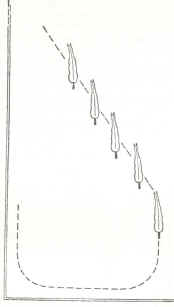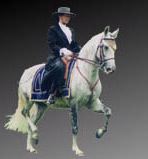 |
classicaldressagescotland.com |
| Lesson 16: Travers and Half-pass |
| New web address: www.classicaldressagescotland.com |  |
| About this site | About us | Personal Tuition | Video analysis | Lesson menu | Portugal and Lusitanos |
| Home Schooling Classical dressage Modern dressage Horse trials Show jumping Glossary Links |
A Bit of BackgroundThere has always been a difference of opinion among the masters whether the travers was a valid and useful exercise. The argument is that a horse tends to be crooked, so why encourage this crookedness by asking the horse to go in a straight line but with the quarters in or off the track.In the words of Alois Podhajsky - Travers (Quarters-in) is a lateral exercise, which is rarely practiced and very seldom applied at the Spanish Riding School. As most horses have a tendency to go crooked, why should this inclination be further encouraged by an exercise in which the hindquarters are taken in from the wall? The possible advantages to be obtained in the bending of the hind legs, improved lateral bending, or increased obedience to the rider's leg aids are so far outweighed by the disadvantages of this movement that it is employed at the Spanish Riding School only in exceptional circumstances. My own view is that the travers is quite an easy exercise to teach, and for the pupil to understand and train his or her horse. Therefore it's useful for the less experienced rider to practice lateral work and Podhajsky has already listed the advantages of the movement above. It has also been my experience that if you teach travers to your pupil they inevitably understand the meaning of crookedness in their horse when it's trying to swing its quarters off the track and the rider is asking the horse to be straight. They have felt the difference between quarters-in and straight; they can feel and recognize the difference. The AidsTravers is used to perfect and manifest the results of the shoulder-in and prepare for half pass: engagement of the quarters, collection as well as flexion and lateral bend. The benefit of working in travers is the crossing over of the outside hind leg, and the increased engagement of the inside hind leg, which has to bend more and carry more weight.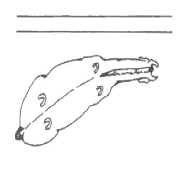
In travers the horses quarters are brought into the school so that the outside hind leg moves a little inside, in the track of the inside foreleg in line behind the inside shoulder. The horse moves into the direction of flexion and bend. (The preparation and first steps towards half pass). The outside legs cross over in front of the inside ones, with the hind legs moving close together towards the center of gravity. The inside hind leg carries more weight and is more bent in all its joints because the horse's mass is moving sideways and across it. There are two ways of starting the movement. The first is: 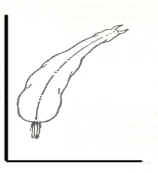
As your horse comes into the corner or finishes a circle with length bend, as the forehand hits the track, put your outside leg behind the girth to push the hind quarters off the track. With shoulder-in you ask for the movement as you come out of the corner or circle. With travers you ask for the movement as you come into the corner or circle. 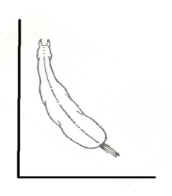 The second way is:
The second way is:
Before starting the travers the rider straightens the horse at the beginning of the long side. At the first marker the rider's outside leg pushes the horse's quarters into the school, off the track. The horse's body will then be at such an angle that the outside hind leg moves inside the track of the inside foreleg. The rider's inside leg close to the girth activates the horse's hind leg. Together with the inside rein it creates and maintains the correct lateral bend. The outside rein controls the degree of bend, secures the position of the neck at its base and supports the influence of the rider's outside leg. The rider's outside leg stays behind the girth confirming that the quarters should be off the track or wall. Together with a soft inside rein it maintains the sideways movement of the horse. Lateral bend and collection are achieved by the rider's inside leg, but only if the horse is absolutely obedient to the outside aids.
The ExercisesBy all means use the travers in your normal day-to-day training. But don't overdo it and use it with other exercises like shoulder-in, half-pass or even renvers (the subject of a further lesson). I have found that if I have a horse that is a little sluggish or not really listening to my leg, that travers then shoulder-in and then travers and then shoulder-in, etc, say ten strides in each movement down one long side, really wakes them up. It's also very good for getting your horse off your leg and teaching obedience.Try a shoulder-in off a circle and then a travers off the circle. Try travers actually on the circle, a circle quarters in. A great preparation and start for pirouettes. Try and half circle (at H) and return to the track (at E) and as you hit the track, (from E) ride travers. Always finish the exercise by making your horse straight before the corner. Now that you and your horse can ride and practice shoulder-in and travers you will find the half-pass relatively easy. Well that's the theory anyway! 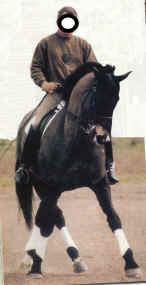
The Half-pass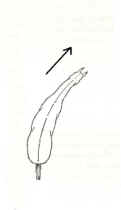 In the half-pass the horse moves equally forwards and sideways away from the wall
or track.
In the half-pass the horse moves equally forwards and sideways away from the wall
or track.
As in travers, the horse is bent around the rider's inside leg and is flexed into the direction of travel. The half-pass is ridden almost parallel to the wall or track, the shoulders always a little in advance of the quarters. This is especially important since the shoulders are slightly narrower than the quarters and therefore the inside shoulder has to be brought that little fraction more into the direction of the movement. What will the half-pass do for you?
The AidsThe aids are near enough the same as travers except you ask from a shoulder-fore or shoulder-in position to establish the length bend. Not a circle or a corner.Before starting the half-pass try to ride a few strides in shoulder-fore or shoulder-in. This is to make sure you have the correct bend around your inside leg and the horse's inside shoulder is leading. Outside leg behind the girth to ask for the quarters to step sideways, inside leg on the girth establishing bend and forward impulsion. Ride into the outside rein. Soft, but adjusting neck bend with the inside rein. The transition into half-pass will be especially fluent if the rider takes care that horse makes the first step sideways with his inside foreleg. Counter-change of hand (or Changing direction in Half-pass) Now this really looks good if done well. Especially in canter with flying changes. When changing direction in a counter-change of hand in half-pass, the horse has first to be straightened after the first half-pass in one direction before he is flexed and bent into the new direction for the second half-pass. To achieve this straightening the rider prepares the horse with half-halts and with forward-driving aids, then brings the forehand in front of the new inside hip. This will, depending on the horse's obedience, take one to three strides in trot, or two in cater. The rider also uses these "straightening strides" to introduce the new inside flexion and bend and to flying change if in canter. He does so with the new inside rein and new outside leg. Take your time when you're teaching your horse these movements. Let it flow and try to enjoy the sensation of moving from one direction to another, going sideways in an easy almost lazy motion without effort.
The Problems.When you are teaching or riding half-pass be aware that things can go wrong and if you don't correct them now / immediately, the problems will rear their ugly head inevitably when you are tense and preoccupied in the competition arena. When a horse makes a mistake and you, the rider let the mistakes perpetuate, then they are no longer mistakes but part of his training.The most common training faults are:
Analyse the way you are sitting and riding (see Rider Errors below). Ride energetically forward regardless of whether he has finished the movement or not. Ride small circles or voltes making sure the horse is off your inside leg and you are not using the inside rein to drag your horse around a circle. Ride figures of eight with lots of changes of length bend, from the leg, not the hand. Ride shoulder-in and travers. Have the movements checked by somebody who knows what they are doing or at least can tell you what is happening or what they seeing from the ground. Ride lots of transitions including transitions from medium to extended trot and canter. Rider ErrorsIt's a strange thing but half-pass is probably the most prepared for exercise in the whole of dressage but the riders get their bodies into such a knot when riding the movement. The most common rider errors in the half-pass are:Incorrect weight distribution.
If you are leaning to the outside, for example you are leaning away from the direction of movement, you are literally stopping your horse from going sideways. A horse will always try and put his balance under your center of gravity. Don't press too hard with the outside leg behind the girth. It will make you stiff and make you lean towards the strong leg. If you find you are leaning away from the movement, stamp into your inside stirrup. Don't lean into the direction, just make sure you don't lean the other way. In other words, sit straight and be still. Collapsing the inside hip, which usually involves the inside hand crossing the withers. Easy one to correct. Don't collapse the inside hip. Don't cross the hands / reins across the wither. Rush the change of direction in counter change of hand.
Take your time. Don't rush. When practicing half-pass with frequent changes of direction it is essential that the rider sits very still and concentrates when giving the aids and that he now uses less outside leg and thinks "shoulder-fore" before starting the half-pass in the new direction. This is especially important if you are in canter and you will have to ride the flying changes. Not sitting quietly enough.
Another easy one to correct. Don't fidget. Let the horse get on with his job. When a horse is going laterally / sideways, he needs you to be at your most supple without you leaping about the saddle. He has to cope with his balance and crossing his legs. He really does not have time to cope with your imbalance.
Trying to push the horse across using brute strength and not technique.
A lesson from Nuno "The legs must be relaxed downwards, near the horse, but soft, without moving they must touch by very short quick instances". Train your horse to listen to small aids. Use finesse, tact and intelligence. With regard for your horse's temperament, don't be afraid to back up your leg with the whip or spur. Always ride for lightness. Horse makes the angle too acute or not enough going sideways.
This has happened because the rider has never ridden or is inconsistent in riding their horse in half-pass to a predetermined place in the school, usually to a marker. Never let your horse simply go sideways. Always, and I mean always, make him go half-pass to somewhere. It's the only way you will ever know you are riding him and not being taken for a ride.
A few exercisesThe first is the simple down the centerline and half-pass to the track. Use the turns to get your length bend. Shoulder-fore for a few strides down the center line and use the horse's natural urge to get back to the track to make the half-pass flow. Leave the centerline at a letter and arrive to the track at a letter.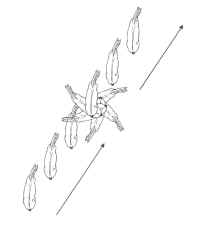
Try the same exercise as above, only shoulder-in or travers down the long side. And just to wet your whistle, the half-pass used as an exercise and preparation for the pirouette.
Thoughts for competitive half-pass.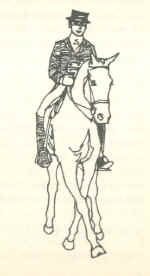 In advanced training and competing the half-pass is performed along the whole
diagonal from one long side across the school to the other long side. The
half-pass and counter change of hand in canter is nearly always down the center
of the school counting each side of the centerline. The distance to be covered
by sideways movement from the centerline is asked for in meters at trot and in
a specified number of strides at canter. The counting is from the touchdown of
the forelegs.
In advanced training and competing the half-pass is performed along the whole
diagonal from one long side across the school to the other long side. The
half-pass and counter change of hand in canter is nearly always down the center
of the school counting each side of the centerline. The distance to be covered
by sideways movement from the centerline is asked for in meters at trot and in
a specified number of strides at canter. The counting is from the touchdown of
the forelegs.
If you have the half-pass movement from the end markers (F, K, H or M) to the centerline say at X, as you come around the corner go straight into shoulder-in or shoulder-fore before the marker. You will then find that you will only have to put your outside leg behind the girth for half-pass at the marker because your are already in shoulder-in so you will not have to worry about bend. Preparation is everything. Just be very, very accurate. You could have the best "going sideyways" horse in the world but if you are all over the arena and not to the markers and the correct count of stride, or your changes are late, you will throw the competition away. Donít forget accuracy is the easiest thing for a dressage rider to accomplish. It's called self discipline. As always, if you have any problems or you don't understand something or any of the above, please get in touch. I found this quote a couple of weeks ago. It's by Kurt Albrecht: "The highest mark should be given when the influence of the rider is invisible. Because of the fact that many riders have a deficient seat, they try to compensate this by increasing the use of the hand and legs." How true. Keep in touch
|
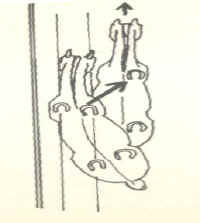 To finish the travers correctly and to return to riding on one track, the horse's
forehand is brought into the school and aligned with the quarters. Use both
reins. Don't do it the other way by pushing with your
inside leg to get the quarters back to the track. You will have you horse's
quarters swinging all over the place like a car with back wheel skid. Not good
for straightness.
To finish the travers correctly and to return to riding on one track, the horse's
forehand is brought into the school and aligned with the quarters. Use both
reins. Don't do it the other way by pushing with your
inside leg to get the quarters back to the track. You will have you horse's
quarters swinging all over the place like a car with back wheel skid. Not good
for straightness.
